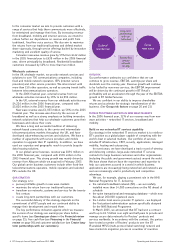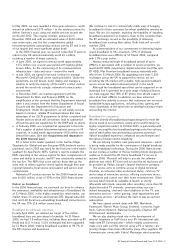BT 2006 Annual Report Download - page 20
Download and view the complete annual report
Please find page 20 of the 2006 BT annual report below. You can navigate through the pages in the report by either clicking on the pages listed below, or by using the keyword search tool below to find specific information within the annual report.More than 98% of eligible employees participate in one or more
of these plans.
Pensions
Most of our employees are members of the BT Pension Scheme
(a defined benefit scheme) or the BT Retirement Plan (a money
purchase scheme), both of which are controlled by independent
trustees. The BT Pension Scheme was closed to new members
on 31 March 2001. The majority of new employees are eligible
to join the BT Retirement Plan. (See Pensions in the Financial
review)
Health and safety
The health and safety of our people is of paramount importance
and we are implementing a group-wide initiative to reduce
levels of accidents and ill health amongst our workforce. We
have reduced the number of accidents leading to absence from
work from 8.6 cases in every million working hours in 2001 to
2.8 cases in every million working hours at 31 March 2006.
Specific initiatives addressed lifting and working at heights and
we continued to enhance our occupational road risk
programme.
In the 2006 financial year, we ran major initiatives on
lifestyle change focusing on exercise, diet and giving up
smoking.
Learning now and for the future
We believe that people, particularly at the start of their careers,
will increasingly want to work for companies that commit to the
long-term development of their employees.
Our successful company-wide re-accreditation to Investors in
People in February 2005, first achieved in 1998, demonstrates
our continuing commitment to the effective alignment of our
communications, training and development with our business
strategy.
We have created a learning governance model to ensure our
learning and development objectives and practice align with the
key strategic objectives of the business. Senior representatives
from all parts of BT sit on the Learning Executive Council and
senior learning and development representatives form the
Learning Council. Both bodies provide strategic and operational
guidance for the whole of BT to ensure that all learning and
development activity is co-ordinated across all lines of business.
In March 2006, we upgraded BT Academy, our web-based
corporate learning portal, to a new platform and renamed it
Route2Learn (R2L). R2L – a group-wide system – is evidence of
our continuing investment in lifelong learning and education for
all BT people. Providing all BT employees with an extensive
range of learning programmes and facilities, it is one of the
largest corporate learning management systems in Europe.
In the 2006 financial year, the BT Academy Learning System
delivered over 250,000 online and nearly 38,000 instructor-led
course completions.
Embedding flexibility and diversity
The changing nature of the markets in which we operate, our
focus on cost leadership and our investment in new services
have impacted the shape of our permanent workforce.
During the 2006 financial year, in the UK more than 6,600
(2005 – 3,903) people joined BT, natural attrition was running
at 3% (2005 – 2.6%) and 2,169 (2005 – 2,685) people left BT
under our voluntary paid leaver package.
We are committed to helping our people optimise their
work/life balance. At the end of March 2006, for example,
around 11,000 people were working from home.
We continue to create a working environment that actively
supports all our employees – regardless of gender, race, sexual
orientation, religion/beliefs, disability or age.
Research and development
The GCTO (Group Chief Technology Office) sets and drives the
open innovation and technology strategy for BT. GCTO includes
a global technology intelligence scouting unit, teams focused on
innovative new wave service opportunities, an innovation
strategy and media team, strategic technology analysis units, a
network and systems architecture team and world-class
research and venturing facilities in Adastral Park (England),
Malaysia and the USA.
In the 2006 financial year, we invested £727 million in
research and development (R&D) to support our drive for
innovation. This investment comprised capitalised software
development costs of £401 million and R&D operating costs of
£326 million. This compares with £522 million in the 2005
financial year, which comprised £265 million of capitalised
software development costs and £257 million of R&D operating
costs.
In addition, the 2006 financial year includes an amortisation
charge of £160 million (2005 – £95 million) in respect of
capitalised software development costs.
This increase in R&D underpins our increased focus on
developing innovative products and services for a converged,
networked world.
We continue to focus our innovation work on key areas
which support our business and technology strategies, filing
patent applications for 141 new inventions in the 2006 financial
year and maintaining a total worldwide portfolio of 7,700
patents and applications.
We have successfully launched eight innovative, independent
start-up companies through the corporate venturing partnership
unit New Venture Partners, in which we are a limited partner.
These start-ups generate value by launching innovative
solutions as high-technology businesses in the global
marketplace.
IT support
Our dedicated IT professionals have a strong track record in the
development and delivery of systems and solutions and in
managing a secure and resilient infrastructure.
Over the past year, we continued to enhance our approach
to systems development through our One IT programme, which
aims to deliver year-on-year reductions in base costs. Our
objective is to transform the various IT units throughout BT into
a single team, rigorously focused on customer requirements.
Our IT strategy is about speed of response and the focusing
of resources in selected areas – at the end of the 2006 financial
year, there were fewer IT systems running in BT than at the
beginning of the year. At its heart is the radical rationalisation
of our systems portfolio, strict adherence to 90-day delivery
cycles and an intense focus on improving the customer
experience.
Property
At 31 March 2006, we occupied approximately 6,500
properties in the UK and approximately 1,500 properties
around the world.
The majority of these UK properties are owned by – and
leased back from – the Telereal Group, which is part of the
William Pears Group.
These properties mainly house exchange equipment and are
needed as part of our continuing activities. Other, general
BT Group plc Annual Report and Form 20-F 2006 Operating and financial review18
























